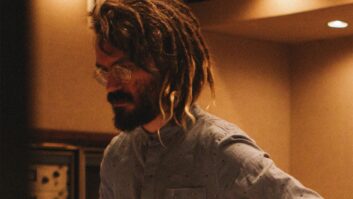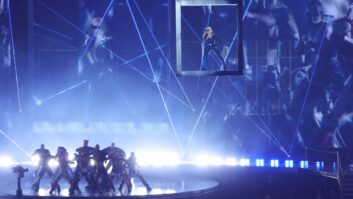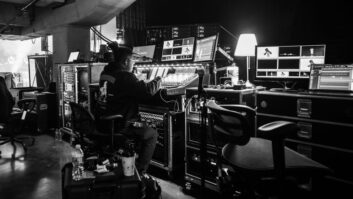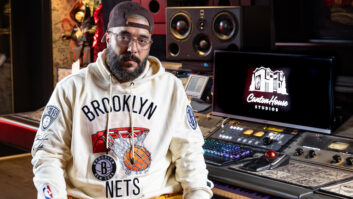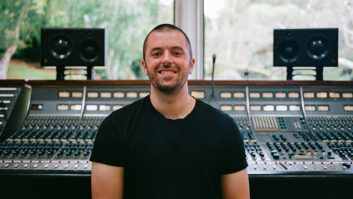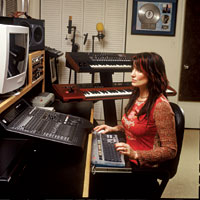
With the record industry seemingly more interested in fat bottomlines than long-term career development, many artists stopped grabbingat the “major-label record deal” brass ring long ago andbegan taking a more proactive role in their business affairs. Inaddition to writing great songs and playing them live, many take-chargeartists, such as the multifaceted artist/songwriter/producer MeredithBrooks, also run their own labels, promote their own“product” and operate their own studios with respectableprofit.
For her 2000 release, Bad Bad One, the self-reliant Brookseither wrote or co-wrote all 12 songs, played rhythm and lead guitars,edited and programmed much of the album, and co-produced and engineeredwith David Darling. Now, Brooks has enough confidence in her technicalabilities to go it alone.
“Now I pretty much don’t even use an engineer,” says theself-taught Brooks, who works on a Pro Tools — equipped ApplePower Mac G4 and a Mackie HUI controller. She owns minimal outboardgear (though she often rents Neve modules and LA-2As), but works withsignal processors such as Warp Factory and Filter Factory, a solid miccollection and, as a reflection of her guitar-wielding beginnings,ample six-strings and guitar amplifiers. “I don’t do any director Amp Farm,” she says. “That helps keep it real, becauseyou can get bogged down in the whole Pro Tools thing.”
Brooks also mixes both her own work and the tracks she produces forother acts. “It’s actually blowing my mind, because the mixessound great to me,” she says. “It’s really freeing that Idon’t have to wait for somebody to mix and then be unhappy with itafterward. I can just noodle on it for a couple of hours, let it sitand come back to it later.”
Brooks recently put her mixing, producing, engineering, songwritingand guitar-playing skills to use with Bec Hollcraft, a14-year-old singer/songwriter whom Brooks is developing. As the oldmusic industry model crumbles, Brooks sees ways for non-Britney —level artists to succeed. “I view myself as the newA&R,” she says. “I’ve gotten hundreds of CDs [from newacts] over the past several months, and they’re all looking for a wayto get their music out there. Because I own my own studio, I’m able tokeep my costs low, so when I do find an artist, I can just go to one ofthe majors for a co-venture.”
In this respect, Brooks says that she’s okay with the machinery ofthe industry, even though, as we all know, it’s got to change.“They’re spending a million dollars on one record, and that’s noteven for promo. There’s something seriously wrong with all that!You can’t keep that going. Artists have to sell millions of records foranybody to make money off of those bloated budgets.”
Ironically, Brooks wrote and produced “Party Up” forPlatinum-selling starlet Hilary Duff’s album, Metamorphosis, andthe album BareNaked from another TV star-turned-pop singer,Jennifer Love Hewitt. Though Hewitt’s album was mostly mixed at Can-AmRecorders in Tarzana, Calif., Brooks does almost all of her work thesedays at her own studio. Even for recording drum tracks — which iswhen many project studio — owning producer/engineers venture tolarger commercial facilities — Brooks now stays in the homeenvironment. “I’m using a lot of drummers now — two inparticular, Russ Miller and Dorian Crozier — who have their ownPro Tools studios with drums set up, and I just bring the files and werecord there and it sounds great. For mixing, [big studios] are still agreat way to go, but I mixed my record at Phil Kaffel’s home studio,mixed and did additional recording on two of Bec’s songs at my friendRob Daiker’s studio and the rest here.”
While Brooks uses session musicians as often as possible, not everyartist does, which hurts both the players and the studios they work in.“I feel the worst for musicians who don’t have studiowork,” Brooks says. “Some artists are in there makingrecords in the big studios, using [drummer] Kenny Aronoff and the bigboys, and that still works for them and that’s great. But when youdon’t have the budget or you’d rather see that budget go to your nextpiece of gear, why spend it on somebody else’s studio? You’ll spend iton your own.”
As an artist with the talent, skills and equipment to create analbum from start to finish entirely on her own, and one who can playmultiple roles for the acts that she produces, Brooks keeps hercalendar (and studio) booked with a variety of projects. Had sheremained bound by the traditional recording artist model, many of theseopportunities might have passed her by. “I’ve been able totransition and flow and change,” she says. “If you can’t,you’re going to get stuck, and then you’re going to be out of work— unless you’ve got an amazing fan base and can tour forever, ifthat’s what you want to do. Frankly, I don’t want to. I’m not intoliving in a bus forever. Even if it did have Pro Tools init!”
Heather Johnson is a Mix editorial assistant.


